formerly eScholarship Editions


|
|
|
|
Your request for similar items found 20 book(s). | Modify Search | Displaying 1 - 20 of 20 book(s) | |
| 1. | 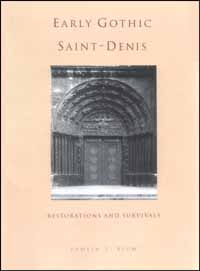 | Title: Early Gothic Saint-Denis: restorations and survivals Author: Blum, Pamela Z Published: University of California Press, 1992 Subjects: Art | Architectural History | Art History | Medieval Studies | Archaeology Publisher's Description: quality. Indeed, the well-preserved sculptural passages provide a key to the Early Gothic style as well as revealing the distinct imprints of three artists and their influences on each other. Blum's penetrating analyses of the restorative techniques and materials are accompanied by telling photograph-diagrams that distinguish the original work from that done later.Pamela Blum's investigation has relevance not only for students and scholars of medieval art but for curators and collectors as well. Anyone concerned with survivals from the past will appreciate her scrupulous detection in studying one of France's greatest monuments. [brief] Similar Items |
| 2. | 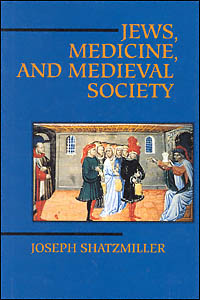 | Title: Jews, medicine, and medieval society Joseph Shatzmiller Author: Shatzmiller, Joseph Published: University of California Press, 1995 Subjects: Jewish Studies | Medieval History | European History | Medieval Studies | Medicine Publisher's Description: Jews were excluded from most professions in medieval, predominantly Christian Europe. Bigotry was widespread, yet Jews were accepted as doctors and surgeons, administering not only to other Jews but to Christians as well. Why did medieval Christians suspend their fear and suspicion of the Jews, allowing them to inspect their bodies, and even, at times, to determine their survival? What was the nature of the doctor-patient relationship? Did the law protect Jewish doctors in disputes over care and treatment?Joseph Shatzmiller explores these and other intriguing questions in the first full social history of the medieval Jewish doctor. Based on extensive archival research in Provence, Spain, and Italy, and a deep reading of the widely scattered literature, Shatzmiller examines the social and economic forces that allowed Jewish medical professionals to survive and thrive in thirteenth- and fourteenth-century Europe. His insights will prove fascinating to scholars and students of Judaica, medieval history, and the history of medicine. [brief] Similar Items |
| 3. | 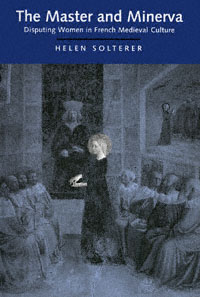 | Title: The master and Minerva: disputing women in French medieval culture Author: Solterer, Helen Published: University of California Press, 1995 Subjects: Literature | European Literature | Literary Theory and Criticism | Medieval Studies | Women's Studies | French Studies Publisher's Description: Can words do damage? For medieval culture, the answer was unambiguously yes. And as Helen Solterer contends, in French medieval culture the representation of women exemplified the use of injurious language.Solterer investigates the debates over women between masters and their disciples. Across a broad range of Old French literature to the early modern Querelle des femmes , she shows how the figure of the female respondent became an instrument for disputing the dominant models of representing women. The female respondent exploited the criterion of injurious language that so preoccupied medieval masters, and she charged master poets ethically and legally with libel. Solterer's work thus illuminates an early, decisive chapter in the history of defamation. [brief] Similar Items |
| 4. | 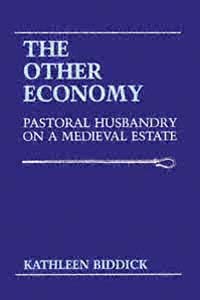 | Title: The other economy: pastoral husbandry on a medieval estate Author: Biddick, Kathleen Published: University of California Press, 1989 Subjects: History | European History | Medieval Studies Publisher's Description: While the cereal agriculture of medieval Europe has been studied exhaustively, the pastoral resources and livestock husbandry of medieval estates have been seriously neglected. Kathleen Biddick's examination of one estate, Peterborough Abbey, during several decades before and after 1100 and the first decade after 1300, brings a new balance to the subject of the medieval economy. Her pioneering methodology and the conclusions she reaches will interest archaeologists and agricultural historians as well as anthropologists, economists, and historians of early European development.Drawing on the archival records of the abbey, an estate that straddled the "classic" open-field agriculture of the English Midlands and the more pastorally-oriented farming of the English peat fens, Biddick describes in great detail how these farmers managed their herds and consumed and marketed livestock products such as meat, wool, hides, milk, and cheese. Commitment to conserving consumption strategies did not mean that the Abbey resisted market involvement and technological innovation. Large numbers of work and cart horses indicate the estate's economic interest in speedy haulage. Cereal yields, where they are calculable, compare favorably to the high-yielding demesnes of parts of Norfolk, the most agriculturally advanced region of medieval England. By showing how the Abbey coordinated its resources to enhance diversity and flexibility, The Other Economy enlarges our understanding of agrarian lordship and political control over resources in the medieval economy. [brief] Similar Items |
| 5. | 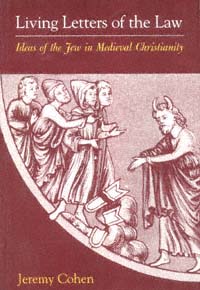 | Title: Living letters of the law: ideas of the Jew in medieval Christianity Author: Cohen, Jeremy 1953- Published: University of California Press, 1999 Subjects: Jewish Studies | Religion | Medieval History Publisher's Description: In Living Letters of the Law , Jeremy Cohen investigates the images of Jews and Judaism in the works of medieval Christian theologians from Augustine to Thomas Aquinas. He reveals how - and why - medieval Christianity fashioned a Jew on the basis of its reading of the Bible, and how this hermeneutically crafted Jew assumed distinctive character and power in Christian thought and culture.Augustine's doctrine of Jewish witness, which constructed the Jews so as to mandate their survival in a properly ordered Christian world, is the starting point for this illuminating study. Cohen demonstrates how adaptations of this doctrine reflected change in the self-consciousness of early medieval civilization. After exploring the effect of twelfth-century Europe's encounter with Islam on the value of Augustine's Jewish witnesses, he concludes with a new assessment of the reception of Augustine's ideas among thirteenth-century popes and friars.Consistently linking the medieval idea of the Jew with broader issues of textual criticism, anthropology, and the philosophy of history, this book demonstrates the complex significance of Christianity's "hermeneutical Jew" not only in the history of antisemitism but also in the broad scope of Western intellectual history. [brief] Similar Items |
| 6. | 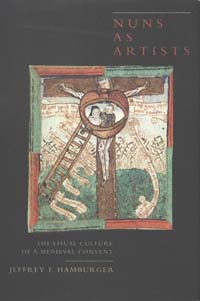 | Title: Nuns as artists: the visual culture of a medieval convent Author: Hamburger, Jeffrey F 1957- Published: University of California Press, 1997 Subjects: Art | Religion | Gender Studies | Art History | Medieval History Publisher's Description: Jeffrey F. Hamburger's groundbreaking study of the art of female monasticism explores the place of images and image-making in the spirituality of medieval nuns during the later Middle Ages. Working from a previously unknown group of late-fifteenth-century devotional drawings made by a Benedictine nun for her cloistered companions, Hamburger discusses the distinctive visual culture of female communities. The drawings discovered by Hamburger and the genre to which they belong have never been given serious consideration by art historians, yet they serve as icons of the nuns' religious vocation in all its complexity. Setting the drawings and related imagery - manuscript illumination, prints, textiles, and metalwork - within the context of religious life and reform in late medieval Germany, Hamburger reconstructs the artistic, literary, and institutional traditions that shaped the lives of cloistered women.Hamburger convincingly demonstrates the overwhelming importance of "seeing" in devotional practice, challenging traditional assumptions about the primacy of text over image in monastic piety. His presentation of the "visual culture of the convent" makes a fundamental contribution to the history of medieval art and, more generally, of late medieval monasticism and spirituality. [brief] Similar Items |
| 7. | 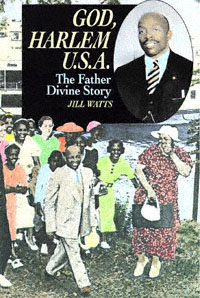 | Title: God, Harlem U.S.A.: the Father Divine story Author: Watts, Jill Published: University of California Press, 1992 Subjects: History | United States History | Christianity | American Studies | African American Studies | African Studies Publisher's Description: How did an African-American man born in a ghetto in 1879 rise to such religious prominence that his followers addressed letters to him simply "God, Harlem U.S.A."?Using hitherto unknown materials, Jill Watts portrays the life and career of one of the twentieth century's most intriguing religious leaders, Father Divine. Starting as an itinerant preacher, Father Divine built an unprecedented movement that by the 1930s had attracted followers across the nation and around the world. As his ministry grew, so did the controversy surrounding his enormous wealth, flamboyant style, and committed "angels" - black and white, rich and poor alike.Here for the first time a full account of Father Divine's childhood and early years challenges previous contentions that he was born into a sharecropping family in the deep South. While earlier biographers have concentrated on Father Divine's social and economic programs, Watts focuses on his theology, which gives new meaning to secular activities that often appeared contradictory. Although much has been written about Father Divine, God, Harlem U.S.A . finally provides a balanced and intimate account of his life's work. [brief] Similar Items |
| 8. | 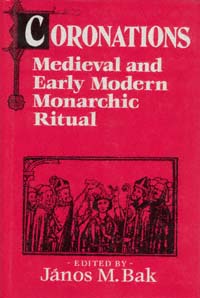 | Title: Coronations: medieval and early modern monarchic ritual Author: Bak, János M Published: University of California Press, 1990 Subjects: History | Medieval History Publisher's Description: Fascination with royal pomp and circumstance is as old as kingship itself. The authors of Coronations examine royal ceremonies from the ninth to the sixteenth century, and find the very essence of the monarchical state in its public presentation of itself. This book is an enlightened response to the revived interest in political history, written from a perspective that cultural historians will also enjoy. The symbolic and ritual acts that served to represent and legitimate monarchical power in medieval and early modern Europe include not only royal and papal coronations but also festive entries, inaugural feasts, and rulers' funerals.Fifteen leading scholars from North America, Britain, France, Germany, Poland, and Denmark explore the forms and the underlying meanings of such events, as well as problems of relevant scholarship on these subjects. All the contributions demonstrate the importance of in-depth study of rulership for the understanding of premodern power structures. Emphasis is placed on interdisciplinary approaches, drawing on the findings of ethnography and anthropology, combined with rigorous critical evaluation of the written and iconic evidence. The editor's historiographical introduction surveys the past and present of this field of study and proposes some new lines of inquiry. "For 'reality' is not a one-dimensional matter: even if we can establish what actually transpired, we still need to ask how it was perceived by those present." [brief] Similar Items |
| 9. | 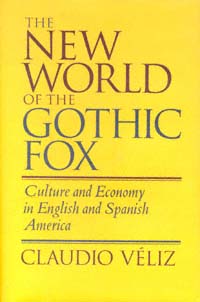 | Title: The New World of the gothic fox: culture and economy in English and Spanish America Author: Véliz, Claudio Published: University of California Press, 1994 Subjects: History | Latin American Studies | Latin American History Publisher's Description: Claudio Véliz adopts the provocative metaphor of foxes and hedgehogs that Isaiah Berlin used to describe opposite types of thinkers. Applying this metaphor to modern culture, economic systems, and the history of the New World, Véliz provides an original and lively approach to understanding the development of English and Spanish America over the past 500 years.According to Véliz, the dominant cultural achievements of Europe's English- and Spanish-speaking peoples have been the Industrial Revolution and the Counter-Reformation, respectively. These overwhelming cultural constructions have strongly influenced the subsequent historical developments of their great cultural outposts in North and South America. The British brought to the New World a stubborn ability to thrive on diversity and change that was entirely consistent with their vernacular Gothic style. The Iberians, by contrast, brought a cultural tradition shaped like a vast baroque dome, a monument to their successful attempt to arrest the changes that threatened their imperial moment.Véliz writes with erudition and wit, using a multitude of sources - historians and classical sociologists, Greek philosophers, today's newspaper sports pages, and modern literature - to support a novel explanation of the prosperity and expanding cultural influence of the gothic fox and the economic and cultural decline endured by the baroque hedgehog. [brief] Similar Items |
| 10. | 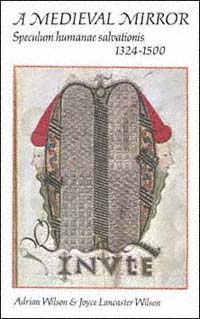 | Title: A medieval mirror, Speculum humanae salvationis, 1324-1500 Author: Wilson, Adrian Published: University of California Press, 1985 Subjects: Art | Architecture Publisher's Description: The Speculum Humanae Salvationis or "Mirror of Human Salvation," is the only medieval work that exists in illuminated manuscripts, in blockbook editions of the mid-fifteenth century, and in sixteen later incunabula. The authors have provided lavishly illustrated accounts of the manuscripts and inclu . . . [more] Similar Items |
| 11. | 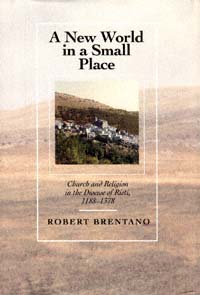 | Title: A new world in a small place: church and religion in the Diocese of Rieti, 1188-1378 Author: Brentano, Robert 1926- Published: University of California Press, 1994 Subjects: History | Religion | Christianity | European History | Medieval History | Medieval Studies Publisher's Description: Distinguished historian Robert Brentano provides an entirely new perspective on the character of the church, religion, and society in the medieval Italian diocese of Rieti from 1188 to 1378. Combing through a cache of previously ignored documents stored in a tower of the cathedral, he uses wills, li . . . [more] Similar Items |
| 12. | 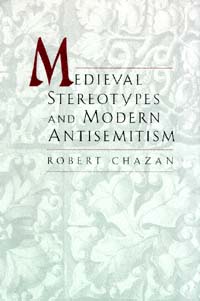 | Title: Medieval stereotypes and modern antisemitism Author: Chazan, Robert Published: University of California Press, 1997 Subjects: Medieval Studies | Jewish Studies | Medieval History | European History | European Studies Publisher's Description: The twelfth century in Europe, hailed by historians as a time of intellectual and spiritual vitality, had a dark side. As Robert Chazan points out, the marginalization of minorities emerged during the "twelfth-century renaissance" as part of a growing pattern of persecution, and among those stigmatized the Jews figured prominently.The migration of Jews to northern Europe in the late tenth century led to the development of a new set of Jewish communities. This northern Jewry prospered, only to decline sharply two centuries later. Chazan locates the cause of the decline primarily in the creation of new, negative images of Jews. He shows how these damaging twelfth-century stereotypes developed and goes on to chart the powerful, lasting role of the new anti-Jewish imagery in the historical development of antisemitism.This coupling of the twelfth century's notable intellectual bequests to the growth of Western civilization with its legacy of virulent anti-Jewish motifs offers an important new key to understanding modern antisemitism. [brief] Similar Items |
| 13. | 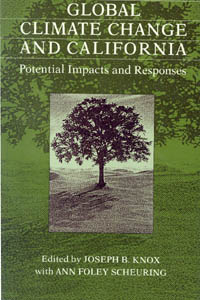 | Title: Global climate change and California: potential impacts and responses Author: Knox, Joseph B Published: University of California Press, 1992 Subjects: Environmental Studies | Ecology | California and the West Publisher's Description: California's extraordinary ecological and economic diversity has brought it prosperity, pollution, and overpopulation. These factors and the state's national and international ties make California an essential test case for the impact of global climate change - temperature increases, water shortages, more ultraviolet radiation. The scientists in this forward-looking volume give their best estimates of what the future holds.Beginning with an overview by Joseph Knox, the book discusses the greenhouse effect, the latest climate modeling capabilities, the implications of climate change for water resources, agriculture, biological ecosystems, human behavior, and energy.The warning inherent in a scenario of unchecked population growth and energy use in California applies to residents of the entire planet. The sobering conclusions related here include recommendations for research that will help us all prepare for potential climate change. [brief] Similar Items |
| 14. | 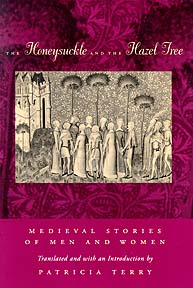 | Title: The honeysuckle and the hazel tree: medieval stories of men and women Author: Terry, Patricia Ann 1929- Published: University of California Press, 1995 Subjects: Literature | Literature in Translation | European Literature | Poetry | Literary Theory and Criticism | French Studies | Medieval Studies | Gender Studies Publisher's Description: Known for her fine translations of octosyllabic narrative verse, Patricia Terry presents translations of four major practitioners of this dominant literary form of twelfth- and thirteenth-century France. Her introduction discusses the varying views of women and love in the texts and their place in the courtly tradition.From Chrétien de Troyes Terry includes an early work, Philomena , here translated into verse for the first time. The other great writer of this period was Marie de France, the first woman in the European narrative tradition. Lanval is newly translated for this edition, which also features four of Marie's other poems. The collection further includes The Reflection by Jean Renart, known for his realistic settings; and the anonymous Chatelaine of Vergi , a fatalistic and perhaps more modern depiction of love. [brief] Similar Items |
| 15. | 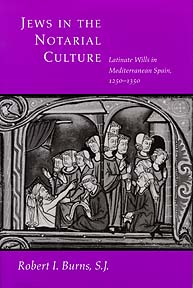 | Title: Jews in the notarial culture: Latinate wills in Mediterranean Spain, 1250-1350 Author: Burns, Robert Ignatius Published: University of California Press, 1996 Subjects: Medieval Studies | Judaism | Jewish Studies | European History | Law | Medieval History Publisher's Description: In the rapidly transforming world of thirteenth-century Mediterranean Spain, the all-purpose scribe and contract lawyer known as the notary became a familiar figure. Most legal transactions of the Roman Law Renaissance were framed in this functionary's notoriously hasty shorthand. Notarial archives, then, offer a remarkable window on the daily life of this pluri-ethnic society. Robert I. Burns brings together the testimony of a multitude of documents, and transcribes in full nearly fifty will-related charters prepared by notaries, to give a never-before-seen view of Jewish society in that place and time.Wills can display the religious conscience, ethical institutions, social mobility, and property dynamics of whole groups or regions. Even a single testament allows a glimpse into the testator's family and into the life and times of the living person. Burns devotes special attention to women in wills and to women's wills, extracting rich information on medieval women and gender relationships.While learning much about the role of kings and courts and the dynamics of Christian-Jewish relations, the reader also gains rare insights into a unique Jewish community. [brief] Similar Items |
| 16. | 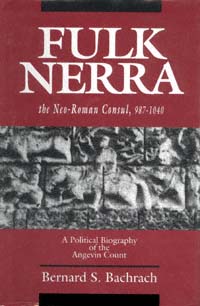 | Title: Fulk Nerra, the neo-Roman consul, 987-1040: a political biography of the Angevin count Author: Bachrach, Bernard S 1939- Published: University of California Press, 1993 Subjects: History | Medieval Studies | Medieval History Publisher's Description: This is the first comprehensive biography of Fulk Nerra, an important medieval ruler, who came to power in his teens and rose to be master in the west of the French Kingdom. Descendant of warriors and administrators who served the French kings, Fulk in turn built the state that provided a foundation for the vast Angevin empire later constructed by his descendants.Bernard Bachrach finds the terms "constructed" and "built" more than metaphorical in relation to Fulk's career. He shows how Fulk and the Angevin counts who followed him based their long-term state building policy on Roman strategies and fortifications described by Vegetius. This creative adaptation of Roman ideas and tactics, according to Bachrach, was the key to Fulk's successful consolidation of political power. Students of medieval and military history will find here a colorful, impressively researched biography. [brief] Similar Items |
| 17. | 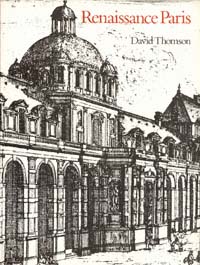 | Title: Renaissance Paris: architecture and growth, 1475-1600 Author: Thomson, David 1912- Published: University of California Press, 1985 Subjects: Art | Architecture Publisher's Description: In the modern literature on Renaissance art and architecture, Paris has often been considered the Cinderella of the European capitals. The prestigious buildings that were erected soon after François I decided in 1528 to make Paris his residence have long since been lost. Thomson, however, restores t . . . [more] Similar Items |
| 18. | 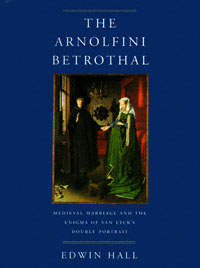 | Title: The Arnolfini betrothal: medieval marriage and the enigma of Van Eyck's double portrait Author: Hall, Edwin 1928- Published: University of California Press, 1997 Subjects: Art | Art History | Art Criticism | Medieval History Publisher's Description: Commonly known as the "Arnolfini Wedding" or "Giovanni Arnolfini and His Bride," Jan van Eyck's double portrait, painted in 1434, is probably the most widely recognized panel painting of the fifteenth century. One of the great masterpieces of early Flemish art, this enigmatic picture has also aroused intense speculation as to its precise meaning. Edwin Hall's accessible study - firmly grounded in Roman and canon law, theology, literature, and the social history of the period - offers a compelling new interpretation of this wonderful painting.Instead of depicting the sacrament of marriage, Hall argues, the painting commemorates the alliance between two wealthy and important Italian mercantile families, a ceremonious betrothal that reflects the social conventions of the time. Hall not only unlocks the mystery that has surrounded this work of art, he also makes a unique contribution to the fascinating history of betrothal and marriage custom, ritual, and ceremony, tracing their evolution from the late Roman Empire through the fifteenth century and providing persuasive visual evidence for their development. His illuminating view of Van Eyck's quintessential work is a striking example of how art continues to endure and engage us over the centuries. [brief] Similar Items |
| 19. | 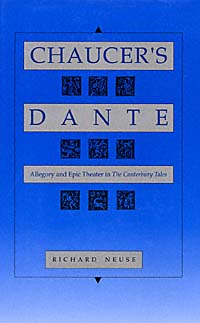 | Title: Chaucer's Dante: allegory and epic theater in The Canterbury tales Author: Neuse, Richard Published: University of California Press, 1991 Subjects: Literature | English Literature | European Literature | Medieval Studies Publisher's Description: Richard Neuse here explores the relationship between two great medieval epics, Dante's Divine Comedy and Chaucer's Canterbury Tales . He argues that Dante's attraction for Chaucer lay not so much in the spiritual dimension of the Divine Comedy as in the human.Borrowing Bertolt Brecht's phrase "epic theater," Neuse underscores the interest of both poets in presenting, as on a stage, flesh and blood characters in which readers would recognize the authors as well as themselves. As spiritual autobiography, both poems challenge the traditional medieval mode of allegory, with its tendency to separate body and soul, matter and spirit. Thus Neuse demonstrates that Chaucer and Dante embody a humanism not generally attributed to the fourteenth century. [brief] Similar Items |
| 20. | 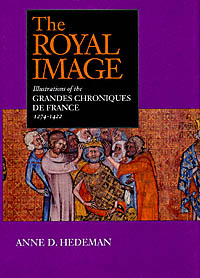 | Title: The royal image: illustrations of the Grandes chroniques de France, 1274-1422 Author: Hedeman, Anne Dawson Published: University of California Press, 1991 Subjects: Art | Art History | Medieval Studies | French Studies Publisher's Description: The Grandes Chroniques de France is a vernacular, frequently illustrated history of the medieval French monarchs. Originally describing the lives of the kings from their origins in Troy in 1274 to the reign of Philip Augustus, it was updated in several stages to the life of Charles VI. Copied and amended for a variety of royal and courtly patrons, approximately 130 of these manuscripts exist today. Anne Hedeman provides the first critical and comprehensive study of the chronicle's illustrations.Hedeman concentrates on the illustrations in twenty manuscripts, analyzing their artistic and cultural significance and offering new methods for studying illustrated manuscripts. She discusses the chronicle in relation to the political ideology of Louis IX, vernacular history, and the Latin chronicle tradition at Saint-Denis. Looking at the manuscripts of various periods, the author compares their representations of historical events, kingship, and individuals in and around the royal court. She also contrasts the styles of several authors and illustrators of the chronicle. The Royal Image includes a catalogue of over seventy-five illustrated manuscripts, and an appendix listing the artists. An additional appendix lists surviving manuscripts. [brief] Similar Items |